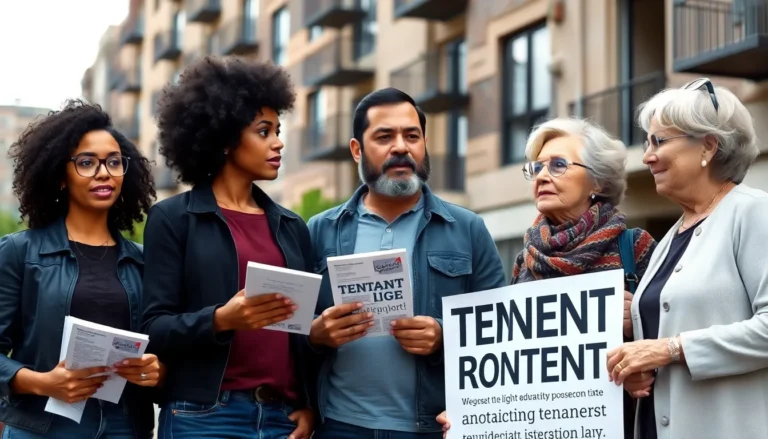Table of Contents
ToggleNavigating the world of renting can feel like a game of dodgeball, with landlords armed and ready to throw curveballs at unsuspecting tenants. But fear not! Tenant protection laws are here to serve as the ultimate shield, ensuring renters aren’t left out in the cold (or worse, without hot water).
These laws are like the unsung heroes of the rental universe, standing guard against unfair practices and ensuring that everyone has a cozy place to call home. With a mix of legal jargon and common sense, they protect tenants from sudden rent hikes and eviction surprises. So, whether you’re a seasoned renter or new to the game, understanding these laws is crucial. Let’s dive into the essentials of tenant protection laws and discover how they keep the rental landscape fair and square.
Overview of Tenant Protection Laws
Tenant protection laws play a crucial role in the rental market. These laws establish clear guidelines that prevent landlords from engaging in unfair practices. Protections often include limits on rent increases, notice requirements for evictions, and rules against retaliatory actions by landlords.
Rent control measures exist in many jurisdictions. They typically restrict how much landlords can increase rent annually. For instance, some cities allow annual rent hikes of only 3% to 5%. Such regulations help maintain housing affordability.
Eviction procedures hinge on established legal frameworks. Most states require landlords to provide written notice before filing for eviction. This notice often gives tenants several days or weeks to address issues, such as overdue rent. By ensuring proper notification, laws protect tenants from sudden displacement.
Retaliation protections safeguard tenants against reprisals. If a tenant complains about unsafe living conditions, for example, landlords cannot evict or harass them in response. These laws encourage tenants to assert their rights without fear of losing their homes.
Security deposit regulations also aim to protect renters. Many jurisdictions limit the amount landlords can demand and require a written agreement outlining terms. When tenants leave, laws often dictate the timeline for returning deposits, ensuring smooth transitions and reduced conflicts.
In the context of housing discrimination, anti-discrimination laws stand firm. These protect tenants from unfair treatment based on race, gender, disability, or familial status. Such protections foster inclusivity and equality in renting practices.
Overall, tenant protection laws create a balanced environment for both landlords and renters, ensuring that rental relationships remain fair and equitable.
Importance of Tenant Protection Laws

Tenant protection laws play a vital role in ensuring fairness within the rental market. They help create a balanced environment for both renters and landlords.
Rights of Tenants
Tenants possess specific rights that safeguard their living conditions. These rights often include protection against unauthorized eviction, allowing tenants to stay in their homes until proper legal processes occur. Additionally, tenants hold the right to receive adequate notice before any rent increase. Local laws frequently dictate these notice periods to ensure transparency. Quality living conditions also fall under tenant rights, requiring landlords to maintain units in a habitable state. Further, tenants can request repairs without fear of retaliation, promoting a safe living environment. Anti-discrimination laws also protect tenants, ensuring fair treatment based on race, gender, or disability status.
Responsibilities of Landlords
Landlords carry essential responsibilities that align with tenant protection laws. Maintaining rental properties in good condition remains a primary duty, ensuring units are safe and habitable. Timely responses to repair requests also fall under their obligations, fostering goodwill between landlords and tenants. Furthermore, landlords must provide tenants with proper notice for rent increases and evictions, abiding by local regulations. Transparency with security deposits is crucial; landlords need to outline deposit handling and return procedures clearly. Respecting tenant privacy forms another important responsibility, requiring landlords to provide notice before entering rental units. Collectively, these responsibilities contribute to a fair and equitable rental relationship.
Key Features of Tenant Protection Laws
Tenant protection laws include critical features designed to secure renters’ rights and promote fairness in the rental market. These laws create a framework that aids tenants in addressing common issues encountered while renting.
Rent Control
Rent control laws establish limits on how much a landlord can increase rent on residential properties. Many jurisdictions enforce regulations that restrict annual rent hikes to a specific percentage, often tied to inflation rates. These measures help maintain housing affordability, especially in high-demand areas. In cities with severe housing shortages, this type of regulation prevents landlords from imposing exorbitant price increases that could displace long-term residents. Rent control also often encompasses rules requiring landlords to offer leases at agreed-upon terms, ensuring transparency in rental agreements.
Eviction Protection
Eviction protection laws protect tenants from unjust displacement. Written notice requirements mandate landlords to inform tenants before initiating eviction proceedings, typically giving them 30 to 60 days of notice. These regulations allow tenants time to address issues or seek legal counsel, preventing sudden evictions. Furthermore, laws often prohibit retaliation against tenants who report unsafe living conditions or assert their rights. Many jurisdictions also require landlords to demonstrate valid reasons for eviction, safeguarding tenants from arbitrary or discriminatory actions. Ultimately, eviction protection contributes to stability and security within housing arrangements.
State-Specific Tenant Protection Laws
Tenant protection laws vary significantly by state, offering different levels of support and regulations for renters. Understanding these nuances is crucial for both tenants and landlords.
California
California enforces strong tenant protection measures. Rent control laws limit annual rent increases, often set at 5% plus inflation, and offer affordability in high-demand markets. The state requires landlords to provide 30 days’ written notice for evictions, allowing tenants time to prepare. Additionally, protections against retaliatory evictions ensure tenants can assert their rights without fear. Maintenance of habitable living conditions is mandated, making landlords accountable for repairs. Furthermore, security deposit regulations cap deposits at two months’ rent for unfurnished units and three months’ rent for furnished ones, promoting transparency and fairness.
New York
New York boasts some of the most comprehensive tenant protections in the country. Rent stabilization limits rent increases for certain apartments, restricting annual hikes to a fixed percentage determined by the Rent Guidelines Board. Landlords must also issue 30-day notice before evictions, giving tenants time to respond or seek legal assistance. The state prohibits retaliatory actions against tenants who request repairs, ensuring safe living environments. Security deposit amounts are capped at one month’s rent, which simplifies the moving process for tenants. Anti-discrimination laws further safeguard renters from unfair treatment, fostering a more inclusive housing market.
Challenges in Implementing Tenant Protection Laws
Implementing tenant protection laws encounters several obstacles. One challenge includes inconsistent enforcement across jurisdictions. State and local variations in regulations create confusion for tenants and landlords alike. This inconsistency often leads to a lack of awareness regarding specific rights and responsibilities.
Limited resources for enforcement agencies also present significant difficulties. Many agencies struggle to effectively monitor compliance with tenant protection laws due to budget constraints. Insufficient staffing can result in delayed response times to tenant complaints and reduced effectiveness in addressing violations.
Another challenge arises from landlords resisting regulations. Some property owners may view tenant protection laws as burdensome. This resistance can influence their willingness to comply and lead to pushback against necessary reforms. Conflict between landlords and tenants will impact the stability of the rental market.
Tenant awareness remains a crucial issue as well. Many renters lack knowledge about their rights under tenant protection laws. Without proper education and access to information, tenants may miss opportunities to seek redress for grievances. Advocacy groups often work to bridge this gap, yet their reach can be limited.
Additionally, policymakers face hurdles when crafting comprehensive laws. Balancing the needs of tenants and landlords requires careful consideration. Complexities involved in drafting effective legislation may result in inadequate protections or loopholes. Stakeholder negotiations can further complicate the process.
Discrimination in housing also poses a challenge to tenant protection efforts. Despite existing anti-discrimination laws, some tenants still face unfair treatment based on race, gender, or other factors. Legal protections may remain ineffective if enforcement is weak.
Implementing tenant protection laws involves navigating a variety of challenges that hinder their effectiveness in promoting fairness in the rental market.
Tenant protection laws play a vital role in creating a fair rental market. They empower renters by safeguarding their rights and ensuring they have a voice against unfair practices. With clear guidelines on rent increases and eviction processes, these laws help maintain stability in housing arrangements.
While challenges in enforcement and awareness persist, the importance of these protections cannot be overstated. They not only promote housing affordability but also foster inclusivity and security for all tenants. As the landscape of rental agreements continues to evolve, understanding and advocating for tenant protection laws remains essential for both renters and policymakers alike.








